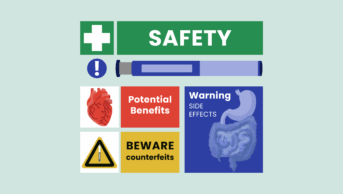
istockphoto.com
Medicines to reduce risk among persons with diabetes or coronary heart disease have been shown to be beneficial in appropriately selected patients. However, older patients with serious comorbidities may have less to gain from intensive treatments that take a long time to achieve benefit because of competing health risks that limit life expectancy. For patients with dementia or poor functional status, the rescue culture of modern medicine can result in a spiral of aggressive therapies that may have little potential for benefit and may instead increase distress[1]
. This realisation has led some researchers to call for deintensification of medical therapy — cutting back on medicines in situations where the potential harms outweigh the potential benefits.
Over-aggressive care
Mr R is an 85-year-old retired plumber with moderate dementia, congestive heart failure, atrial fibrillation, type 2 diabetes, hypertension, hyperlipidaemia, and chronic kidney disease. He takes 16 daily prescribed medicines despite declining cognition, falls, iatrogenic hypoglycaemia and his wife’s caregiver strain. Given Mr R’s age and comorbidities, his five-year mortality risk is greater than 50%[2]
. He has little likelihood of benefitting from medicines taken in an effort to prevent long-term complications from his comorbidities.
Like Mr R, many older adults have multiple chronic diseases and take numerous medicines concurrently. The risk of adverse drug reactions increases with age because of physiologic changes in drug metabolism, cognitive impairment that may cause patients to take medicines incorrectly, and polypharmacy[3]
. Commonly used medicines that are beneficial in younger, healthier people may lead to decreased physical function and quality of life in some older adults by causing symptoms such as postural hypotension, dizziness, falls, fatigue, confusion and anorexia. Drug-drug interactions and drug-disease interactions may be misdiagnosed as geriatric syndromes or ‘normal’ ageing.
Several recent studies have raised concerns about the delivery of burdensome and potentially over-aggressive care, especially for frail older adults
Several recent studies have raised concerns about the delivery of burdensome and potentially overaggressive care, especially for frail older adults like Mr R, who are nearing the end of life. The management of type 2 diabetes is an example. Clinical practice guidelines recommend haemoglobin A1c targets of less than 7% for younger, healthier adults with diabetes to reduce the risk of microvascular complications[4],[5]
. Given that the time to attain these microvascular benefits is 10–20 years[6]
, the harms of such intensive therapy outweigh the benefits for older adults in frail health. Hypoglycaemia rates are twice as high for older patients (≥75 years) compared with younger patients, and around 25% of emergency hospital admissions for adverse drug events in older adults are attributed to glucose-lowering agents. Hospital admission rates for hypoglycaemia exceed the rates for hyperglycaemia among older adults[7]
.
Changing habits
Changing prescribing habits is a slow process. A recent study using data from the National Health and Nutrition Examination Survey, which is representative of the US population, found that approximately 60% of older adults with type 2 diabetes in the poorest health — corresponding to 1 million people — were treated with insulin or sulfonylureas to achieve tight glycaemic targets (hemoglobin A1c level, <7%)[8]
. Like Mr R, these patients had substantial comorbid illness and functional impairments. They were more likely to experience short-term harm from aggressive management of their diabetes than long-term benefit.
Hypertension illustrates another situation in which deintensification of therapy may be beneficial. Most people aged over 70 years have hypertension and there is strong evidence that antihypertensive treatment reduces the absolute risk of cardiovascular events — from 15.3 to 11.0 per 100 participants within 4.5 years[9]
. But older adults with substantial comorbidities and limited life expectancy may consider factors other than cardiovascular risk reduction to be more important[10],[11]
. Common adverse effects of antihypertensive agents, such as gait impairment, dizziness and postural hypotension, may negatively impact quality of life on a day-to-day basis. In addition, antihypertensives may increase the risk of serious fall injuries, such as traumatic brain injury and hip fracture, which have consequences on function and mortality similar to that of myocardial infarction and stroke in older adults[12]
. The balance of aggressive antihypertensive therapy seems to tip more toward harm for the frailest older adults. Among nursing home residents aged 80 years or over, a recent study found that those treated with combination anti-hypertensive therapy (two or more blood pressure agents) to achieve a systolic blood pressure of less than 130mmHg had a greater than two-fold risk for mortality over two years of follow up compared with similar patients who received no or one antihypertensive drug[13]
.
Time to deintensify
Several initiatives are under way to limit the harms of overtreatment. Annual drug regimen review is an indicator for quality prescribing in vulnerable older adults and can identify high-risk medicines, potential drug-drug or drug-disease interactions, and unnecessary medicines — prime targets for deintensification[14]
. Such annual reviews were also recommended by the American Geriatrics Society (AGS) as part of the Choosing Wisely initiative in 2014[15]
. Choosing Wisely is a national campaign of the American Board of Internal Medicine Foundation that seeks to educate the public about medical tests, procedures and treatments that are commonly performed despite limited evidence of benefit.
With respect to diabetes, the AGS recommended that “glycaemic targets should reflect patient goals, health status, and life expectancy. Reasonable glycaemic targets would be 7.0–7.5% in healthy older adults with long life expectancy, 7.5–8.0% in those with moderate comorbidity and a life expectancy <10 years, and 8–9% in those with multiple morbidities and shorter life expectancy[15]
.” Other societies, including the American Diabetes Association, have also recommended relaxing glycaemic targets for older adults with significant comorbid illness and functional impairment[4]
, and emphasised that the goal of treatment should be to prevent acute symptoms of hyperglycaemia. The US Department of Veterans Affairs, which provides health care to more than 8 million veterans per year, has instituted a national hypoglycaemia safety initiative to encourage shared decision-making and appropriate deintensification of diabetes medicines among patients at highest risk for hypoglycaemia.
Despite the growing body of evidence of the harms of overly aggressive therapy in older adults with poor functional status or limited life expectancy, there are few data to guide clinicians in deintensifying therapies. How can clinicians identify patients who are good candidates for deintensification? Which medicines should not be started or should be stopped? How can such medicines be safely discontinued to avoid symptoms?
There is some evidence to inform discussions with patients and caregivers. For example, a recent study of nearly 400 patients with advanced life-limiting illnesses (estimated life expectancy 6–12 months), who were taking statins for primary or secondary prevention of cardiovascular disease, showed that discontinuing statins in this patient population was not associated with higher mortality and trended toward improved quality of life[16]
. Additional data are needed to limit the harms of overtreatment and to improve the well-being of older adults with serious illness.
Conversations between providers and patients should incorporate patient life expectancy and goals of care
In its 2012 ‘Guiding principles for the care of older adults with multimorbidity’, the AGS advises clinicians on how to identify situations in which the harms of intensive therapy may outweigh the benefits, and how to navigate decisions about whether to implement or continue treatments for older adults with multiple chronic conditions[2]
.
More initiatives are needed to foster shared decision making about treatment intensity. Conversations between providers and patients should incorporate patient life expectancy and goals of care. Research should focus on determining the likelihood of competing outcomes under different treatment strategies and for older adults with complex health, who are typically under-represented in clinical trials. In addition, we need to improve methods for eliciting patient preferences and helping patients and families make treatment decisions.
Clinical practice guidelines and physician quality metrics should incentivise physicians for deintensifying therapy in the appropriate situation. Given the ageing population, more efforts are needed to ensure that older adults, particularly those on the cusp of losing their independence or near the end of life, avoid unnecessary or harmful medical therapies and receive rational, patient-centred care.
Ariel R Green is assistant professor of medicine and Bruce Leff is professor of medicine at the Division of Geriatric Medicine and Gerontology, Johns Hopkins University School of Medicine, Baltimore, Maryland.
References
[1] Lee SJ, Lindquist K, Segal MR et al. Development and validation of a prognostic index for 4-year mortality in older adults. JAMA 2006;295:801–808. doi: 10.1001/jama.295.7.801
[2] Guiding principles for the care of older adults with multimorbidity: an approach for clinicians: American Geriatrics Society Expert Panel on the Care of Older Adults with Multimorbidity. J Am Geriatr Soc 2012;60:E1–E25. doi: 10.1111/j.1532-5415.2012.04188.x
[3] Buchman TG, Cassell J, Ray SE et al. Who should manage the dying patient?: Rescue, shame, and the surgical ICU dilemma. Journal of the American College of Surgeons 2002;194:665–673. doi: 10.1016/S1072-7515(02)01157-2
[4] Standards of medical care in diabetes 2014. Diabetes Care 2014;37:S14–80. doi: 10.2337/dc14-S014
[5] Garber AJ, Abrahamson MJ, Barzilay JI et al. AACE comprehensive diabetes management algorithm 2013. Endocr Pract 2013;19:327–336. PMID:23598536
[6] Kirkman MS, Briscoe VJ, Clark N et al. Diabetes in older adults. Diabetes Care 2012;35:2650–2664. doi: 10.2337/dc12-1801
[7] Lipska KJ, Ross JS, Wang Y et al. National trends in US hospital admissions for hyperglycemia and hypoglycemia among Medicare beneficiaries, 1999 to 2011. JAMA Intern Med 2014;174:1116–1124. doi: 10.1001/jamainternmed.2014.1824
[8] Lipska KJ, Ross JS, Miao Y et al. Potential overtreatment of diabetes mellitus in older adults with tight glycemic control. JAMA Intern Med 2015;175:356–362. doi: 10.1001/jamainternmed.2014.7345
[9] Musini VM, Tejani AM, Bassett K et al. Pharmacotherapy for hypertension in the elderly. The Cochrane Database of Systematic Reviews 2009:CD000028. doi: 10.1002/14651858.CD000028.pub2
[10] Tinetti ME, McAvay GJ, Fried TR et al. Health outcome priorities among competing cardiovascular, fall injury, and medication-related symptom outcomes. J Am Geriatr Soc 2008;56:1409–1416. doi: 10.1111/j.1532-5415.2008.01815.x
[11] Tinetti ME & Kumar C. The patient who falls: “It’s always a trade-off”. JAMA 2010;303:258–266. doi: 10.1001/jama.2009.2024
[12] Tinetti ME, Han L, Lee DS et al. Antihypertensive medications and serious fall injuries in a nationally representative sample of older adults. JAMA Intern Med 2014;174:588–595. doi: 10.1001/jamainternmed.2013.14764
[13] Benetos A, Labat C, Rossignol P et al. Treatment with multiple blood pressure medications, achieved blood pressure, and mortality in older nursing home residents: The PARTAGE Study. JAMA Intern Med 2015;175:989–995. doi: 10.1001/jamainternmed.2014.8012
[14] Shrank WH, Polinski JM & Avorn J. Quality indicators for medication use in vulnerable elders. J Am Geriatr Soc 2007;55(2):S373–382. doi: 10.1111/j.1532-5415.2007.01345.x
[15] American Geriatrics Society identifies another five things that healthcare providers and patients should question. J Am Geriatr Soc 2014;62:950–960. doi: 10.1111/jgs.12226
[16] Kutner JS, Blatchford PJ, Taylor DH Jr et al. Safety and benefit of discontinuing statin therapy in the setting of advanced, life-limiting illness: a randomized clinical trial. JAMA Intern Med 2015;175:691–700. doi: 10.1001/jamainternmed.2015.0289


